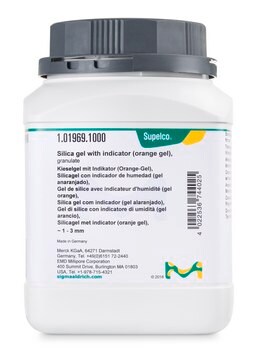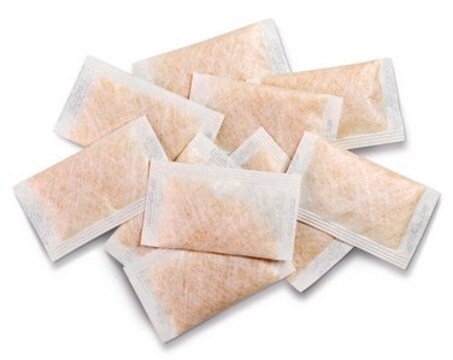1.01905
Gel de sílice
granules, desiccant ~ 0.2 - 1 mm
About This Item
Productos recomendados
Nivel de calidad
Formulario
granular
potencia
>5000 mg/kg LD50, skin (Rabbit)
superficie
700 m2/g
pérdida
≤2.0% loss on drying, 180°C
tamaño de partícula
0.2-1 mm
tamaño de poro
2.0-2.5 nm
pH
7 (20 °C, 100 g/L in H2O, slurry)
bp
2230 °C
mp
>1600 °C
densidad aparente
200‑800 kg/m3
temp. de almacenamiento
15-25°C
cadena SMILES
O=[Si]=O
InChI
1S/O2Si/c1-3-2
Clave InChI
VYPSYNLAJGMNEJ-UHFFFAOYSA-N
¿Está buscando productos similares? Visita Guía de comparación de productos
Aplicación
- Stability and Structure of Potentially Atmospherically Relevant Glycine Ammonium Bisulfate Clusters: This research examines the complex interactions and stability of atmospheric aerosols involving sulfuric acid, providing insights valuable for environmental scientists and chemists studying atmospheric chemistry and pollution mitigation strategies (Hariharan et al., 2024).
- Nanostructured Niobium and Titanium Carbonitrides as Electrocatalyst Supports: Discusses the role of sulfuric acid in synthesizing nanostructured materials for energy applications, relevant for material scientists and researchers in renewable energy technologies (McLeod et al., 2024).
- Synthesis and characterization of hydroxyapatite nanoparticles from calcium hydroxide fouled with gases evolved from the smokestack of the glass industry: Highlights the utility of sulfuric acid in the synthesis of nanoparticles for industrial applications, crucial for researchers in materials science and industrial manufacturing (Abdelmoaty and Mousa, 2024).
- Nucleophilic hydrolysis enables HF-etched MXene kilofarad specific capacitance and excellent rate performance: Demonstrates the application of sulfuric acid in enhancing the performance of electrochemical storage devices, relevant for material scientists working on advanced battery technologies (Xu et al., 2024).
Nota de análisis
Loss on drying (180 °C): ≤ 2.0 %
Water absorption capacity (24 hrs.,80 % relative humidity): ≥ 27.0 %
Código de clase de almacenamiento
13 - Non Combustible Solids
Clase de riesgo para el agua (WGK)
nwg
Punto de inflamabilidad (°F)
Not applicable
Punto de inflamabilidad (°C)
Not applicable
Certificados de análisis (COA)
Busque Certificados de análisis (COA) introduciendo el número de lote del producto. Los números de lote se encuentran en la etiqueta del producto después de las palabras «Lot» o «Batch»
¿Ya tiene este producto?
Encuentre la documentación para los productos que ha comprado recientemente en la Biblioteca de documentos.
Los clientes también vieron
Nuestro equipo de científicos tiene experiencia en todas las áreas de investigación: Ciencias de la vida, Ciencia de los materiales, Síntesis química, Cromatografía, Analítica y muchas otras.
Póngase en contacto con el Servicio técnico




